Maybe you never noticed them. Or perhaps walking around Babson day after day, you stopped seeing them, the many landmarks on campus, the monuments, artwork, and memorials to the dearly departed.
This tour of Babson Park, while far from definitive, hopes to shine a light on those overlooked places passed by every day, the forgotten spots and nooks that silently remind us of the decades gone by and the people who came before. “Babson has a lot of history,” says Dick Bishop, P’86, who worked for 20 years at Babson and retired in 1998 as director of strategic projects. “Babson has a great many stories that have never been told.”
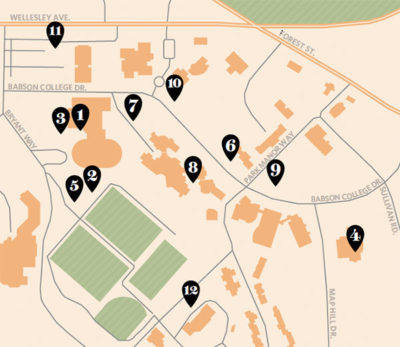
Map Illustration: Michael Newhouse
The numbers in the map correspond with the landmarks listed below.
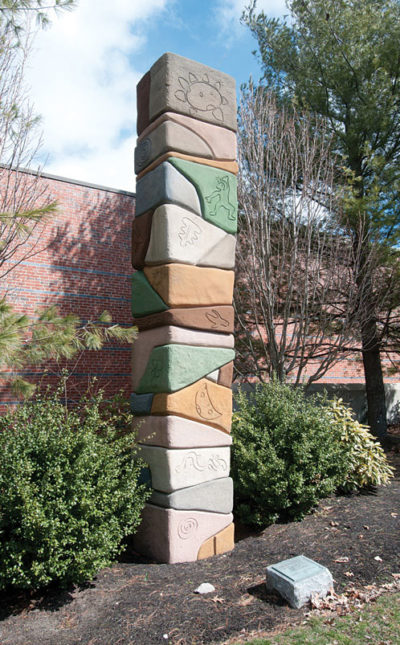
Babson Totem
No 1 Babson Totem
Near the Webster Center entrance stands a celebration of life. Colorful, uplifting, and surreal, the Babson Totem is dedicated to John Bassett ’87, who lived with a life-threatening heart ailment and passed away from cancer in 1988. Shane Kennedy ’76, an all-American goalie while at Babson, made the totem pole. He’s an artist, designer of residential gardens, and soccer coach living in Mill Valley, Calif. “I’m an artist-jock,” Kennedy says. The piece was fabricated in Abilene, Texas, and took about a week to finish. Foam was wrapped around four steel supporting pipes, and then it was shaped with a chain saw. Next, concrete was applied to the foam, aluminum foil was pressed into the concrete to give texture, and images were carved into the structure by hand. Once the piece was finished, it was trucked up from Texas and put in place via a crane.

Chew-it Marker
No 2 Chew-it Marker
On a path to the Upper Athletic Fields is a marker that’s easy to miss. Weathered by time, it commemorates the establishment of the presentday Babson campus in 1921. The marker includes an inscription that reads in part: “Bite off more than you can chew, then chew it. Plan for more than you can do, then do it.”
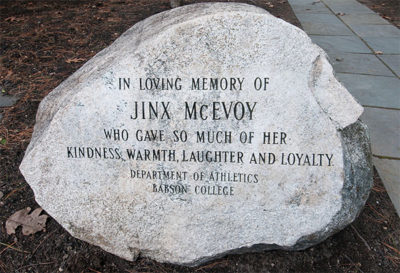
Jinx Memorial
No 3 Jinx Memorial
Jinx McEvoy was a sweetheart. A long-time administrative assistant in the Athletics Department, she kept the office running smoothly. “She was a very upbeat, cheery, wonderful human being,” says Norm Govoni, marketing professor, assistant baseball coach, and a campus fixture since 1970. “She was a vital part of athletics.” After McEvoy passed away in 1999, a memorial was placed near the tennis courts. It was the perfect spot—she had been an avid player. “We wanted to do something so she wouldn’t be forgotten,” says Judy Blinstrub, women’s basketball coach since 1984. “Hers was the smile you wanted to see every morning.”
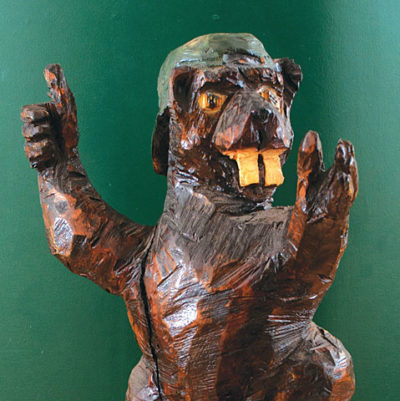
Beaver Sculpture
No 4 Beaver Sculpture
Inside Trim Dining Hall, a wooden beaver sculpture stands guard like a sentry. Artist Michael Higgins made the beaver using an unusual method. “It was all done with a chain saw,” says Terry Sullivan, P’14, Babson’s supervisor of architectural trades. “In no time he created that.” Sullivan remembers the noisy day Higgins came to campus, sawing wood outside Reynolds, chips and dust flying. In just a half-hour, the work was done.
No 5 Roger’s Grave

Roger’s Grave
Growing up, Sullivan spent much time on campus. His father was Ed Sullivan, a longtime Babson employee who was director of the physical plant. In 1967, the young Sullivan had a half-day from school, so he headed over to campus. He didn’t know this was to be a somber and important day, as College founder Roger Babson was laid to rest. Sullivan doesn’t recall much about the funeral. He remembers his father making last-minute preparations to the gravesite, located near the Upper Athletic Fields, and he remembers the weather. “It was a rainy, cold day,” Sullivan says.
No 6 Bird Art

Bird Art
Looked at from a certain angle, the metal artwork outside of Park Manor South appears to be a bird. “I think it’s a rooster,” says Bill Dill, H’91, who was Babson’s president during the 1980s when the untitled piece of art was installed. “That’s what I recollect.” A construction project about 10 years ago displaced the bird from its original location near Roger’s Pub and sent it into storage, where it stayed for a number of years. Finally, about six years ago, the art was re-installed in its present location during the summer, Sullivan says, which left students puzzled when they returned for the fall semester. Babson Free Press even wrote about the bird’s appearance. “They were trying to figure out where it came from,” Sullivan says.
No 7 Cherry Trees
In bloom they are beautiful, but that beauty is fleeting. For a little while every spring, a group of 10 cherry trees turns a path near the Webster Center a pretty pink. The trees were planted in memory of Fumitaka Oishi, who died in a car crash in 1989 just before starting at Babson. David Carson, who began working at Babson in 1968 and retired as director of planning in 1999, says, “The family wanted to do something to honor their son.”

Atom Art
No 8 Atom Art
In the mid-1970s, the College began beautifying the campus by acquiring and exhibiting art. “It was a major effort,” Carson says. “There wasn’t a lot of art on campus.” Coming to Babson were two similar works, the larger Ominous Ikon #6 and the smaller Yaddo Study, both made of Corten steel and located near Gerber Hall. “The pieces are solid,” says artist Dennis Kowal, who lives in Sarasota, Fla. “They will outlive all of us.” When creating the pieces, Kowal was thinking of a nuclear bomb’s mushroom cloud, of how something so destructive could be so beautiful. As a child, he remembers seeing footage of an atom-bomb test in a movie theater. “I was literally on the floor,” he says. “That really had a serious effect on me.”
No 9, 10, 11 Roger’s Markers
Milestones from Roger Babson’s life are celebrated on several stone markers. One by Park Manor Central recalls Babson’s Statistical Organization, the influential clearinghouse of financial information. Another by Luksic Hall remembers Babson’s membership in the Society to Eliminate Economic Causes of War, which sought to create the League of Nations. Still another marker by Knight Auditorium commemorates Babson’s famous prediction of the 1929 stock market crash. According to an old campus walking tour, all three monuments were erected in the late 1950s and early 1960s, when Babson was in his 80s. “That was later in life for him, making sure people remembered what he did,” says Jesse Putney ’56, MBA’59, P’90, ’93, who has many ties to the College. His grandfather was a trustee in the 1930s, his father was a treasurer, and Putney himself worked at Babson from 1964 until 1991, retiring as chief financial officer. “He was a pretty eccentric chap,” Putney says of Babson, “but he was quite a businessman back in the day.”
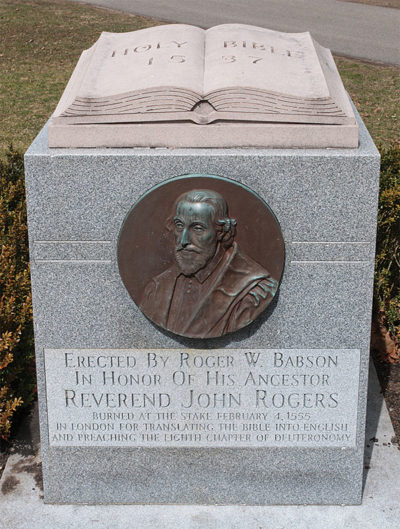
Burned at the Stake Monument
No 12 Burned at the Stake Monument
Out of all the campus landmarks, this may be the most mysterious. Standing outside Coleman Hall, it memorializes a Roger Babson ancestor burned at the stake in 1555 for translating the Bible into English and preaching the eighth chapter of the book of Deuteronomy. No one interviewed for this story knew anything about the monument. “That’s been there since I was a kid,” Sullivan says. “I’ve always been fascinated by it.” A religious man, Babson referred to his ancestor, the Rev. John Rogers, in a 1955 newspaper editorial. “When I think of [him] … I feel ashamed of myself for the little effort I am making to increase Bible reading,” Babson wrote.
